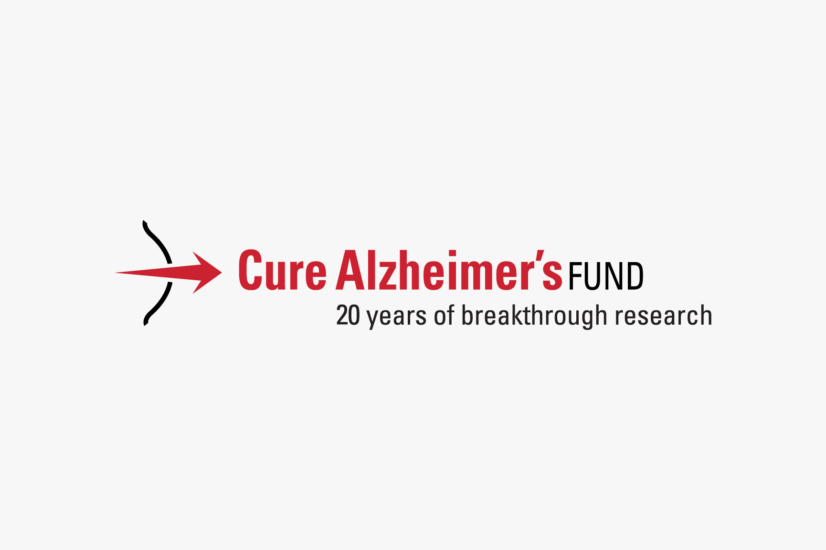This is a list of papers funded by Cure Alzheimer’s Fund. It also includes “layperson” descriptions of each paper. We are grateful to the researchers for translating the work of their papers into language more accessible to most of us than the more precise technical language useful to them and their peers.
We thank all the researchers and lab personnel for their dedication and commitment to the common mission of ending this disease, and we congratulate all of them for the important work reflected in these papers.
We also are grateful to all of those who literally made this work possible. Without those of you who have supported Cure Alzheimer’s Fund projects through your generosity, these papers and the forward momentum they represent would not exist.
Alzheimer’s Genome Project
Kim M, Hersh LB, Leissring MA, Ingelsson M, Matsui T, Farris W, Lu A, Hyman BT, Selkoe DJ, Bertram L, Tanzi RE. Decreased catalytic activity of the insulin degrading enzyme in chromosome 10-linked Alzheimer’s disease families. J Biol Chem, 2007; 282(11):7825-32.
This paper represents a functional follow-up of earlier genetic findings obtained by Drs. Bertram and Tanzi that suggest a modest but significant increase in AD risk conferred by genetic variants in the insulin degrading enzyme (IDE) in certain familial AD cases. The paper revealed that the potential biochemical mechanism underlying the genetic association may be a reduced activity of IDE in these families. Since IDE is one of the major A-beta degrading enzymes, this finding could be of immediate relevance as less A-beta degradation could lead to a buildup of beta-amyloid plaques, one of the hallmark lesions in the brains of AD patients.
Kavvoura FK, McQueen MP, Khoury MJ, Tanzi RE, Bertram L, Ioannidis JPA. Evaluation of the potential excess of statistically significant findings reported genetic association studies: application to Alzheimer’s disease. Am. J. Epidemiol. 2008; Published Ahead of Print.
This study addressed how best to assess composite statistical data in determining bonafide AD candidate genes using a novel state-of-the-art analysis.
Bertram L, Tanzi RE. Thirty Years of Alzheimer’s Disease Genetics:Implications from Systematic Meta-analyses. Nature Reviews Neuroscience, 2008 Oct;9(10):768-78.
This is a review article highlighting the potential functional implications underlying the most consistent genetic associations observed via systematic meta-analyses performed as part of AlzGene. The paper also provides a background on the statistical approach of AlzGene and other novel methodologies in complex disease genetics.
Fardo D, Bertram L, Dalila P, Lazarus R, Becker KD, Manolio T, O’Donnell C, Neale B, Lasky-Su J, Daly M, Faraone S, Scherer S, Weiss S, Tanzi R, Lange C. Using transmission rates in family-based genome-wide association studies to estimate platform-speciï¬c genotyping errors that cannot be detected by standard quality control ï¬ltering. A. J. Epidemiol.; In Press.
This review proposes a new approach in detecting errors in genome-wide association (GWA) studies using transmission rates in family-based data. The approach highlights certain technological weaknesses inherent in the GWA approach that cannot be detected in a simple case-control setting, which is the predominant design in the vast majority of current genome-wide studies.
Schjeide BM, Hooli B, Parkinson M, Hogan MF, DiVito J, Mullin K, Blacker D, Tanzi RE, Bertram L. Follow-up of genome-wide association results suggests GAB2 as an Alzheimer’s disease susceptibility gene. Archives Neurol.; In Press.
This study confirms the gene known as GAB2 plays a role in genetic susceptibility to AD in analyses of more than 1,300 families with AD.
Schaffer BAJ, Bertram L, Miller BL, Mullin K, Weintraub S, Johnson N, Bigio EH, Mesulam M, Wiedau-Pazos M, Jackson GR, Cummings JL, Cantor RM, Levey AI, Tanzi RE, Geschwind DH. Association of GSK3B with Alzheimer’s Disease and Frontotemporal Dementia. Archives Neurol.; In Press.
This study describes a genetic association between risk for Alzheimer’s disease and the gene known as GSK3B. We found this gene to be associated with risk for frontotemporal dementia, which involves tangle-type pathology, but not beta-amyloid. The GSK3B gene produces a protein that is known to regulate both beta-amyloid production and tangle formation.
Schjeide, BM, McQueen MB, Mullin K, DiVito J, Hogan MF, Parkinson M, Lange C, Blacker D, Tanzi RE, Bertram L. Assessment of Alzheimer’s disease case-control associations using family-based methods. Neurogenetics; Published Ahead of Print.
This study addresses which AD candidate genes identified through case-control studies and analyzed on the Alzgene.org website play a role in genetic susceptibility to AD in family-based studies of more than 1,300 families with AD. Three novel AD genes were confirmed in these analyses.
Bertram L, Lange CL, Mullin K, Parkinson M, Hsiao M, Hogan MF, Schjeide BMM, Hooli B, DiVito J, Ionita I, Jiang H, Laird N, Moscarillo T, Ohlsen KL, Elliott K, Wang X, Hu-Lince D, Ryder M, Murphy A, Wagner SL, Blacker D, Becker KD, Tanzi RE. Genome-wide association analysis reveals novel Alzheimer’s disease susceptibility loci in addition to APOE. Am. J. Hum. Genet.; In Press.
This paper describes the results of the first family-based genome-wide association study in Alzheimer’s disease. The primary screen was performed using the Affymetrix 500K SNP chip array in ~1,400 hundred individuals from more than 400 multiplex AD families. Overall, four novel putative AD genes were identified in addition to the well-established APOE association. Two of these novel associations were replicated in nearly 3,000 additional and independent family-based samples. The results strongly imply the existence of at least two novel AD risk genes that are independent of APOE.
Lu A, Romano DM, Soininen H, Hyman BT, Bertram L, Tanzi RE. Effects of ubiquilin 1 on the unfolded protein response. J. Mol. Neurosci.; In Press.
This paper represents a functional follow-up of earlier genetic findings obtained by Drs. Bertram and Tanzi that suggest a modest but significant increase in AD risk conferred by genetic variants in the ubiquilin-1 (UBQLN1) gene in certain familial AD cases. This paper shows that changes in the expression of UBQLN1 can have substantial effects on the unfolded protein response (UPR), a general cellular defense mechanism against the accumulation of unfolded or misfolded proteins, including accumulated Abeta.
Relationship of Stroke or Brain Injury to Alzheimer’s Disease
Brody DL, Magnoni S, Schwetye KE, Spinner M, Esparza TJ, Stocchetti N, Zipfel GJ, Holtzman DM. Amyloid-β Dynamics Correlate with Neurological Status in the Injured Human Brain. Science 2008.
This paper backs up previous work that shows that nerve cell communication is directly linked with levels of the amyloid-beta peptide. In this work, we show in the human brain in critically ill patients with head injury and certain types of stroke that the amyloid-beta peptide levels are dynamically very closely linked with the clinical state of the patient. If the patient is doing better, it increases; if they are going to do worse, it decreases. This may turn out to be a useful method to help physicians decide how to treat critically ill patients with brain damage.
Tesco G, Koh YH, Kang E, Cameron A, Das S, Sena-Esteves M, Hiltunen M, Yang S-H, Zhong Z, Shen Y, Simpkins J, Tanzi RE. Depletion of GGA3 stabilizes BACE and enhances ατεβ-secretase activity. Neuron, 2007; 54(5):721-37.
It has been known for several years that strokes and head injuries can increase the risk of Alzheimer’s disease, but the mechanism underlying that increased risk has not been understood. Dr. Tesco’s group has shown how brain cell death caused by these traumas can lead to the production of amyloid-beta through the dysregulation of BACE levels in the brain. She identified a novel mechanism of regulation of BACE levels and activity by the trafficking molecule GGA3 (golgi-localized gamma-ear-containing ARF binding protein 3).
The importance of GGA3’s control of BACE levels was supported by the observation that, in brain tissue from Alzheimer’s patients, reductions in GGA3 corresponded with elevations in BACE, particularly in those areas most affected by the disease.
This work shows that stroke, and perhaps head trauma, can trigger a series of biochemical events that increase amyloid-beta production in the brain, and subsequent development of Alzheimer’s disease. Novel therapies could interfere with this process and reduce the risk of Alzheimer’s disease in stroke or head trauma patients.
Anesthesia and A-beta
Zhang B, Dong Y, Zhang G, Moir RD, Xia W, Yue Y, Tian M, Culley DJ, Crosby G, Tanzi RE, Xie Z. The inhalation anesthetic desflurane induces caspase activation and increases amyloid-beta protein levels under hypoxic conditions. J Biol Chem., 2008; 2;283(18):11866-75.
This study shows that the commonly used anesthetic desflurane, when administered to nerve cells in petri dishes, and combined with hypoxia (shortage of oxygen), increases levels of Abeta protein and causes cell death.
Zhang G, Dong Y, Zhang B, Ichinose F, Wu X, Culley DJ, Crosby G, Tanzi RE, Xie Z. Isoflurane-induced caspase-3 activation is dependent on cytosolic calcium and can be attenuated by memantine. J Neurosci, 2008; 28:4551-60.
This study showed that the detrimental effects of the general anesthetic isoflurane on nerve cells could be ameliorated by treatment with the Alzheimer’s drug memantine (Namenda) in mice.
Xie Z, Culley DJ, Dong Y, Zhang G, Zhang B, Moir RD, Frosch MP, Crosby G, Tanzi RE. The common inhalation anesthetic isoflurane induces caspase activation and increases Aβ level in vivo. Annals of Neurology; In Press.
This study shows that the commonly used anesthetic isoflurane, when administered to mice, increases Abeta protein levels and causes nerve cell death.
Dong Y, Zhang G, Zhang B, Moir D, Xia W, Marcantonio ER, Culley DJ, Crosby G, Tanzi RE, Xie Z. The common inhalational anesthetic sevoflurane induces apoptosis and increases Aβ levels. J. Clin. Invest.; Submitted.
This study shows that the commonly used anesthetic sevoflurane, when administered to nerve cells in petri dishes, increases levels of Abeta protein and causes cell death.
ACAT Investigations
Huttuner HJ, utter-Paier B, Barren C, Peach C, Havas D, Duller S, Xia W, Frosch MP, Windisch M, Kovacs DM. The ACAT Inhibitor CI-I0II Reverses Diffuse Brian Amyloid Pathology in Aged hAPP Mice. Proceedings of the National Academy of Science, 2008.
This study suggests potential therapeutic applications of BACE1 inhibitors in treating sodium channel dysfunction in AD patients. BACE1 is one of the two enzymes responsible for generation of the amyloid beta peptide (Abeta), a pathogenic molecule that accumulates in the brains of patients affected by Alzheimer’s disease (AD). We now know that BACE1 is not only important for generation of Abeta but also for regulating neuronal sodium channel (Na(v)1) activity. Previous work suggests that elevated BACE1 activity in AD patients would not only increase Abeta levels in the brains of patients, but also contribute to psychiatric symptoms and epileptic seizures by modifying sodium channel activity.
Oligomer Investigations
Berman DE, Dall’Armi C, Voronov SV, McIntire LBJ, Zhang H, Moore AZ, Staniszewski A, Arancio O, Kim T, Di Paolo G. Oligomeric amyloid-beta peptide disrupts phosphatidylinositol-4, 5-bisphosphate metabolism. Nature Neuroscience, 2008.
In the brains of Alzheimer’s disease patients, the levels of a small protein piece, called amyloid β-peptide (Aβ), are highly elevated. Researchers have found that Aβ directly attacks and interferes with the normal function of brain nerve cells, resulting in the impairment of memory, which is a common feature of Alzheimer’s disease. This study reveals that increasing the level of a specific membrane lipid, called PIP2, protects the nerve cells against the harmful Aβ effects. Accordingly, this study helps to devise a novel route of discovery for effective Alzheimer’s disease drugs, which protect neurons by modulating the PIP2 membrane lipid.
Choi SH, Veeraraghavalu K, Lazarov O, Marler S, Ransohoff RM, Ramirez JM, Sisodia SS. Non-Cell-Autonomous Effects of Presenilin 1 Variants on Enrichment-Mediated Hippocampal Progenitor Cell Proliferation and Differentiation. Neuron, 2008.
Genetic, early-onset familial forms of AD (termed FAD) are caused by inheritance of mutant genes that code for presenilin 1 (PS1). We discovered that these mutant genes impair the self-renewal and neuronal differentiation of stem cells (termed NPCs) in the adult hippocampus, a region of the brain that is critical for making and consolidating memory. In patients with AD, the hippocampus is the region most profoundly affected by the presence of pathological lesions and neuronal cell loss, leading to memory impairments. Thus, perturbations in those processes that are critical for the generation and survival of stem cells that differentiate into neurons in the hippocampus will ultimately compromise memory function. More importantly, we have shown that these impairments in NPC proliferation and neuronal differentiation are modulated by other cells, including microglia, that are resident in the hippocampus. We have identified a number of proteins that are secreted by microglia that are essential for these processes. This may be of therapeutic value in attenuating neuronal deficits and associated dysfunction leading to memory and cognitive impairments in patients with AD.
Microdialysis Drug Discovery Platform
Cirrito JR, Kang J, Lee J, Stewart FR, Verges D, Silverio LM, Bu G, Mennerick S, Holtzman DM. Endocytosis is required for synaptic activity-dependent release of amyloid-beta in vivo. Neuron, 2007.
The level of the amyloid-beta peptide in the brain throughout life is important in determining whether the beginnings of Alzheimer’s disease, the buildup in the brain of the amyloid-beta protein, actually start to occur. In this work, we found that nerve cell communication is directly linked to the formation of the amyloid-beta peptide and the details of how this happened. In the future, this work suggests new methods and treatments to develop that might be used to decrease the buildup of amyloid in the brain.







